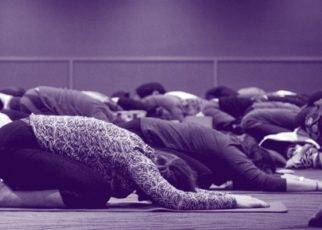Yoga classes can be an integral part of many fitness training and sporting activities. The postures and poses are beneficial for sports that require explosive activity or a precision state of mind, such as racquet sports, power lifting, sprinting, basketball, volleyball or baseball. Additionally, yoga increases core strength, increases flexibility and range of motion, improves balance, assists breathing and is good for cross training.
Warrior Series for Racquet Sports, Running and Soccer
Athletes can implement sports yoga into their training program by practicing yoga after sports training, or by cross training on off-days or days of “rest.” After intense athletic training sessions, yoga poses and postures can accelerate the body’s recovery and prepare the athlete for the next workout.
Standing postures such as with the Warrior series are beneficial for strengthening the lunging legs and useful for opening up the side of the body and hips. This is especially useful in racquet sports, running and soccer. Increasing the space in the joints is beneficial with these high-impact, weight-bearing activities. Additionally, postures that focus on maintaining mobility and range of motion in the joints such as the hips, knees and ankles are useful.
Backbends for Cycling and Strength Training
Cyclists may over-tax the quadriceps and hip flexors, and may benefit from back bending postures to open up the front of the body. Additionally, cyclists with over-developed quadriceps would benefit from postures that elongate the hamstrings. Cobra pose and downward-facing dog can strengthen the arms and shoulders and improve the posture and alignment approximated in the saddle.
Back bends, such as wheel or bow pose, also increase the suppleness of the spine, which is important as the essential oxygen delivery mechanism to all parts of the body. Such postures work to lengthen the muscles and increase joint flexibility, counteracting some of the contractile effects of strength training.
Breathing Exercises for Swimming
Yoga’s practice of controlled breathing is beneficial for swimmers and during the performance of other endurance sports. Synchronized breathing during vinyasa flow poses as well as pranayama breathing during meditation can help oxygenate the body and focus the mind. In addition to increasing lung capacity, practicing yoga breathing techniques can serve to energize and relax both the mind and body. Yoga’s practice of meditation and concentration allow the athlete to increase self-awareness so they are attuned to early symptoms of injury and pain, correct their course of action, and reduce stress on the body.
Focused breathing is very important for swimmers, but they can also benefit from the flexibility and strength benefits of practicing yoga. Downward and upward facing dog can help prevent rotator cuff and shoulder tendonitis. Postures such as pigeon pose and bound angle pose can help open up hips that may only be used in the breaststroke. Hero pose with a focus on the ankles as a foundation of movement during a swimmer’s kick can be helpful as well.
An athlete that exclusively focuses on one or two sports would benefit from incorporating sports yoga into their cross training and reducing injuries from overuse, alleviating training boredom, and adding variety and recovery periods to their training regimen.




